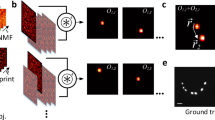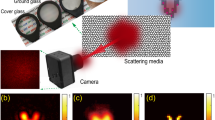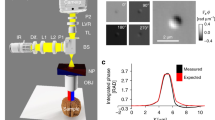Abstract
Non-invasive optical imaging techniques, such as optical coherence tomography1,2,3, are essential diagnostic tools in many disciplines, from the life sciences to nanotechnology. However, present methods are not able to image through opaque layers that scatter all the incident light4,5. Even a very thin layer of a scattering material can appear opaque and hide any objects behind it6. Although great progress has been made recently with methods such as ghost imaging7,8 and wavefront shaping9,10,11, present procedures are still invasive because they require either a detector12 or a nonlinear material13 to be placed behind the scattering layer. Here we report an optical method that allows non-invasive imaging of a fluorescent object that is completely hidden behind an opaque scattering layer. We illuminate the object with laser light that has passed through the scattering layer. We scan the angle of incidence of the laser beam and detect the total fluorescence of the object from the front. From the detected signal, we obtain the image of the hidden object using an iterative algorithm14,15. As a proof of concept, we retrieve a detailed image of a fluorescent object, comparable in size (50 micrometres) to a typical human cell, hidden 6 millimetres behind an opaque optical diffuser, and an image of a complex biological sample enclosed between two opaque screens. This approach to non-invasive imaging through strongly scattering media can be generalized to other contrast mechanisms and geometries.
This is a preview of subscription content, access via your institution
Access options
Subscribe to this journal
Receive 51 print issues and online access
$199.00 per year
only $3.90 per issue
Buy this article
- Purchase on Springer Link
- Instant access to full article PDF
Prices may be subject to local taxes which are calculated during checkout




Similar content being viewed by others
References
Abramson, N. Light-in-flight recording by holography. Opt. Lett. 3, 121–123 (1978)
Huang, D. et al. Optical coherence tomography. Science 254, 1178–1181 (1991)
Nasr, M. B., Saleh, B. E. A., Sergienko, A. V. & Teich, M. C. Demonstration of dispersion-canceled quantum-optical coherence tomography. Phys. Rev. Lett. 91, 083601 (2003)
Ntziachristos, V. Going deeper than microscopy: the optical imaging frontier in biology. Nature Methods 7, 603–614 (2010)
Ishimaru, A., Sermsak, J. & Kuga, Y. Imaging through random multiple scattering media using integration of propagation and array signal processing. Waves Rand. Compl. Media 22, 24–39 (2012)
Sheng, P. Introduction to Wave Scattering, Localization and Mesoscopic Phenomena (Academic, 1995)
Strekalov, D. V., Sergienko, A. V., Klyshko, D. N. & Shih, Y. H. Observation of two-photon “ghost” interference and diffraction. Phys. Rev. Lett. 74, 3600–3603 (1995)
Bennink, R. S., Bentley, S. J. & Boyd, R. W. “Two-photon” coincidence imaging with a classical source. Phys. Rev. Lett. 89, 113601 (2002)
Freund, I. Looking through walls and around corners. Physica A 168, 49–65 (1990)
Mosk, A. P., Lagendijk, A., Lerosey, G. & Fink, M. Controlling waves in space and time for imaging and focusing in complex media. Nature Photon. 6, 283–292 (2012)
Katz, O., Small, E. & Silberberg, Y. Focusing and compression of ultrashort pulses through scattering media. Nature Photon. 5, 372–377 (2011)
van Putten, E. G. et al. Scattering lens resolves sub-100 nm structures with visible light. Phys. Rev. Lett. 106, 193905 (2011)
Hsieh, C.-L., Pu, Y., Grange, R., Laporte, G. & Psaltis, D. Imaging through turbid layers by scanning the phase conjugated second harmonic radiation from a nanoparticle. Opt. Express 18, 20723–20731 (2010)
Fienup, J. R. Phase retrieval algorithms: a comparison. Appl. Opt. 21, 2758–2769 (1982)
Miao, J., Charalambous, P., Kirz, J. & Sayre, D. Extending the methodology of X-ray crystallography to allow imaging of micrometre-sized non-crystalline specimens. Nature 400, 342–344 (1999)
Gibson, A., Hebden, J. & Arridge, S. Recent advances in diffuse optical imaging. Phys. Med. Biol. 50, R1–R43 (2005)
Culver, J. P., Ntziachristos, V., Holboke, M. J. & Yodh, A. G. Optimization of optode arrangements for diffuse optical tomography: a singular-value analysis. Opt. Lett. 26, 701–703 (2001)
Fink, M. Time reversed acoustics. Phys. Today 50, 34–40 (1997)
Yaqoob, Z., Psaltis, D., Feld, M. S. & Yang, C. Optical phase conjugation for turbidity suppression in biological samples. Nature Photon. 2, 110–115 (2008)
Popoff, S. M. et al. Measuring the transmission matrix in optics: an approach to the study and control of light propagation in disordered media. Phys. Rev. Lett. 104, 100601 (2010)
Vellekoop, I. M. & Aegerter, C. Scattered light fluorescence microscopy: imaging through turbid layers. Opt. Lett. 35, 1245–1247 (2010)
Feng, S., Kane, C., Lee, P. A. & Stone, A. D. Correlations and fluctuations of coherent wave transmission through disordered media. Phys. Rev. Lett. 61, 834–837 (1988)
Freund, I., Rosenbluh, M. & Feng, S. Memory effects in propagation of optical waves through disordered media. Phys. Rev. Lett. 61, 2328–2331 (1988)
Akkermans, E. & Montambaux, G. Mesoscopic Physics of Electrons and Photons 427–439 (Cambridge Univ. Press, 2007)
Katz, T., Small, E. & Silberberg, Y. Looking around corners and through thin turbid layers in real time with scattered incoherent light. Nature Photon. 6, 549–553 (2012)
Fienup, J. R. Reconstruction of an object from the modulus of its Fourier transform. Opt. Lett. 3, 27–29 (1978)
Dainty J. C., ed. Laser Speckle and Related Phenomena (Springer, 1984)
Abbey, B. et al. Lensless imaging using broadband X-ray sources. Nature Photon. 5, 420–424 (2011)
Thurman, S. T. & Fienup, J. R. Phase retrieval with signal bias. J. Opt. Soc. Am. A 26, 1008–1014 (2009)
Wang, L. V. & Hu, S. Photoacoustic tomography: in vivo imaging from organelles to organs. Science 335, 1458–1462 (2012)
Acknowledgements
We thank W. L. Barnes for discussions and for reading the manuscript, and M. Claessens, V. Subramaniam and J. Schleipen for discussions and for help with samples and equipment. This work is supported by the Stichting Technische Wetenschappen and the Stichting voor Fundamenteel Onderzoek der Materie, which are financially supported by the Nederlandse Organisatie voor Wetenschappelijk Onderzoek (NWO). J.B. acknowledges a grant by FIRB-MIUR ‘Futuro in Ricerca’ (project RBFR08UH60). A.P.M. acknowledges a ‘Vidi’ grant from NWO and European Research Council grant no. 279248.
Author information
Authors and Affiliations
Contributions
All authors take full responsibility for the content of the paper.
Corresponding author
Ethics declarations
Competing interests
The authors declare no competing financial interests.
Supplementary information
Supplementary Information
This file contains Supplementary Text and Data, Supplementary Figures 1-4 and Supplementary References. (PDF 230 kb)
Rights and permissions
About this article
Cite this article
Bertolotti, J., van Putten, E., Blum, C. et al. Non-invasive imaging through opaque scattering layers. Nature 491, 232–234 (2012). https://doi.org/10.1038/nature11578
Received:
Accepted:
Published:
Issue Date:
DOI: https://doi.org/10.1038/nature11578
This article is cited by
-
Coincidence imaging for Jones matrix with a deep-learning approach
npj Nanophotonics (2024)
-
Optimizing multi-user indoor sound communications with acoustic reconfigurable metasurfaces
Nature Communications (2024)
-
Pilot-assisted beam and correlation to recover information through scattering media [Invited]
Applied Physics B (2024)
-
Directly and instantly seeing through random diffusers by self-imaging in scattering speckles
PhotoniX (2023)
-
Tracing multiple scattering trajectories for deep optical imaging in scattering media
Nature Communications (2023)
Comments
By submitting a comment you agree to abide by our Terms and Community Guidelines. If you find something abusive or that does not comply with our terms or guidelines please flag it as inappropriate.



